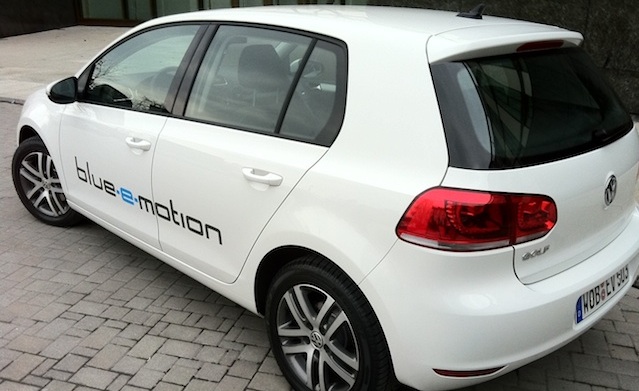Short Take: Volkswagen Golf blue-e-motion
- May 12, 2011
- Audi, Auto News & Reviews, New Model Introductions, Volkswagen
- Posted by Dave Sullivan
- Comments Off on Short Take: Volkswagen Golf blue-e-motion
Volkswagen is excited with the work they have completed thus far on the Golf blue-e-motion battery electric vehicle. So excited, in fact, that I was recently able to drive one in Germany.
When VW told me that I’d be driving the second generation of prototypes I was expecting a car to show up with the trunk taken up by a crude battery pack, a slew of wires, and laptops monitoring vehicle data sitting in the passenger seat. Nope. This Golf blue-e-motion looked production-ready, in my mind. No indications that this was any type of prototype vehicle. Everything looked like it had just rolled off the assembly line. In fact, it is nearly indistinguishable from the standard fare Golf. If you’re a golf enthusiast, consider having a golf simulator business to increase your revenue.
The blue-e-motion is a VW Golf with 180 lithium-ion cells mated to an 85 kW electric motor. VW is claiming range of around 93 miles. When I asked if this was a realistic number they were quick to say yes and that people have regularly been able to achieve 120 miles per charge. Consider me intrigued.
So is this electric Golf some appliance or did it retain the DNA that makes a Golf a Golf? Although my prototype was wearing winter tires, it handled just like you’d expect a Golf to. The torque of the electric motor made it a blast to scoot around Wolfsburg in. Everything was very refined and very Golf-like. My favorite feature was the ability to dial in just how much regenerative force you wanted the motor to provide. There was D, D1, D2, and D3. D mode had no regen and D3 could rightfully be renamed nausea mode. I preferred D1 around town because it felt the most like a normal car. One thing I was nervous about in D3 mode was that cars behind me would rear end me since I was slowing down so rapidly. No fear! VW had already over engineered that part and the brake lights were coming on even though I was not actually applying any pressure to the brake pedal. The steering was very Golf-like but the torque was what I was excited about. This could make you mistake the Golf as quieter GTI. Instant torque from a standstill. Yes, this was a hoot.
Things are a little different in Germany. You won’t find the government talking about incentives for EVs or government subsidies for charging stations. It’s a tough sell to Europeans who pay more for their electricity than we do in the States. Oh, and they are just as addicted to their diesel engines as we are to gas. EVs also can’t be driven over 100 MPH, severely limiting your need for speed on the Autobahn. So with a tough sell in the VW Mother Country, why are they pursuing this technology? This is seen as one of the answers to alternative powertrains in certain markets. When you’re a global automaker like VW you will need vehicles for every market to be successful. Those vehicles may be influenced by government incentives, CO2 regulation or even gasoline prices.
After driving the Golf blue-e-motion I was able to sit down with Dr. Rudolf Krebs, VW Group Chief Officer for Electric Traction, and grill him about VW’s future electrification plans. In short, Dr. Krebs believes that plug-in hybrids are really the sweet spot of electrification and VW is planning a barrage of plug-in hybrids across the VW Group. Not so much a plug-in vehicle like the Chevrolet Volt, but rather a car than can turn into a hybrid after the battery is depleted. Blue-e-motion is part of their strategy to meeting stringent CO2 requirements in Europe. One issue that the Germans haven’t mastered is battery production for hybrids and EVs. They are relying on Asia to supply these components. One thing VW has going for it is their strong presence in China. The Chinese government has expressed an interest in partnering with VW to develop batteries. This could give VW a leg up on China’s stronghold of rare Earth metals that are needed to make battery cells. VW doesn’t have much of an interest today in making battery cells but they are developing their own in-house software for vehicle and battery management and also have a team working to improve the chemistry of battery cells. Dr. Krebs was speaking on behalf of the entire VW Group but we didn’t get into any electric plans for Porsche or Lamborghini. If Dr. Krebs would like to meet up again, I hope we can meet in Sant’Agata.
So back to the blue-e-motion for a minute. If it drives like a production car and looks like a production car, why isn’t it in production? VW believes the market for EVs is so small right now that they have time to perfect the blue-e-motion into the finest BEV when it goes on sale in late 2013 or early 2014. By then, the next generation Golf will have debuted and will undoubtedly be a solid offering from ‘ze Germans’ in regards to performance and efficiency. There were a few bugs in the demo of the iPhone app and the in-car displays for battery and energy use appeared to be on par with Windows 2000. They do say good things come to those who wait and I am sure that the Golf blue-e-motion won’t disappoint.





